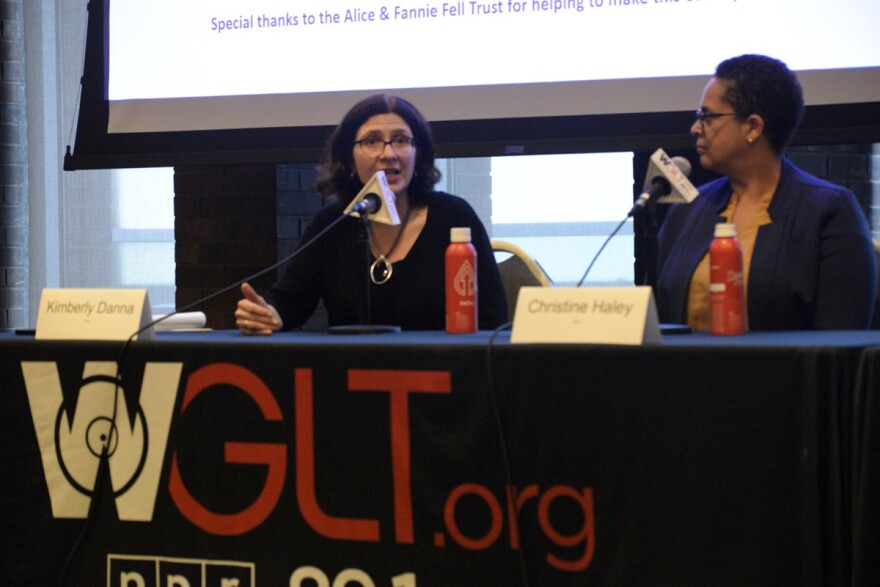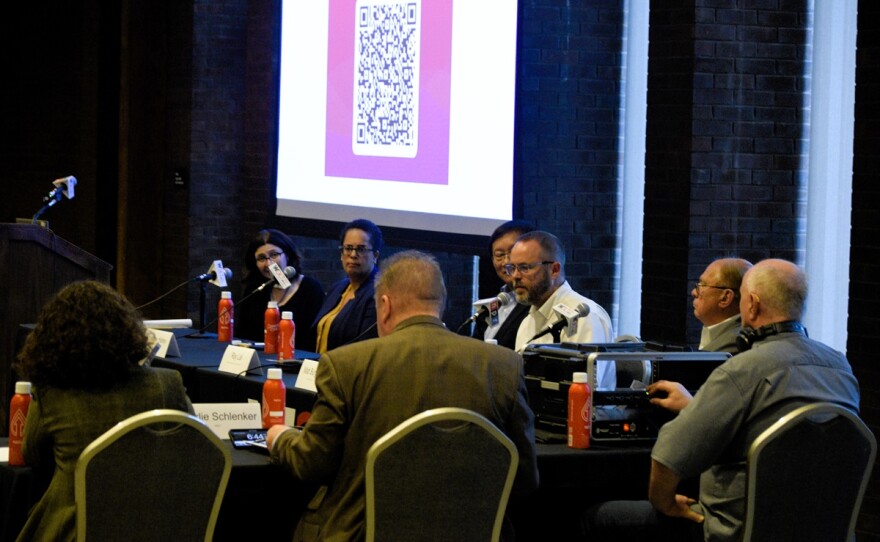State and federal housing advocates detailed a wide range of government programs to help reduce Bloomington-Normal’s housing shortage — while local stakeholders outlined the barriers that remain — during a housing solutions forum held Wednesday at Illinois State University.
WGLT hosted the event at Bone Student Center in response to community housing demands that have escalated in recent years due, in part, to job expansions at electric vehicle company Rivian, candy maker Ferrero and other employers.
"We need to look at humanitarian relief and dignity as much as we can."Home Sweet Home Ministries CEO Matt Burgess
Kimberly Danna, Illinois field office director for the U.S. Department of Housing and Urban Development [HUD], explained the agency's priorities are to create more market-rate and affordable housing and to preserve its existing affordable housing stock.
Danna detailed a range of new and ongoing programs that can assist homeowners, renters, property managers, even health care providers and nursing home operators. She said HUD has received increased funding in recent years to provide housing for the elderly and people with disabilities.
“These are places that, I think this area Bloomington, Normal, McLean County, could really spend some time investigating,” she said.
HUD has several new programs, Danna added, including one that offers $4 billion in loans and $800 million in grants to stabilize homes for energy efficiency and climate change.
“There needs to be a sophisticated look at what funds are available and what are the challenges to getting them,” said Danna, adding many of the programs have limited timeframes to apply.

“We need to get the money out,” she said.
Christine Haley with Illinois Department of Human Services [IDHS] was appointed the state’s first homelessness chief in 2021.
She indicated the new state budget, which Illinois lawmakers approved early Wednesday, significantly boosts funding to address homelessness by providing $290 million for court-based rental assistance, legal aid for those in eviction court, other homeless prevention services, and for rapid rehousing and shelter.
Haley said Illinois saw a 30% annual jump in homelessness in 2023, the most recent data available, adding state officials are still exploring reasons for the sudden increase after years of declines.
The racial divide among Illinois’ homeless population is vast, and especially so in Bloomington-Normal and nearby communities, she said, noting state data show Black people make up 45% of Illinois’ homeless population and 14% of the general population.
Data from McLean County and 10 nearby counties that make up a regional Continuum of Care show Black people are 10 times more likely to experience homelessness than white residents. That’s the sixth-widest disparity among Illinois’ 19 Continuum of Care regions.
Haley also pointed to data showing homelessness can be deadly — the unhoused have a life expectancy nearly 20 years shorter than the rest of the population.
“We have significant work to do to be able to close that mortality gap,” she said.
Haley stressed affordable housing was the key to reducing homelessness and that mental illness and substance abuse make up a small percentage of those who are unhoused.
She said Illinois’ more robust housing stock has kept it’s homeless rates much lower than California and New York, for example.
“It’s not because we in Illinois have figured out how to cure mental illnesses and substance use. Those rates are relatively the same, but we have a different type of housing market,” said Haley, adding Illinois offers a number of incentives for landlords to make housing more affordable, such as rent subsidies.
Developers
Bloomington Realtor and developer Ed Neaves said he was encouraged to learn more about some of the government programs outlined during the forum and felt that would boost home construction in Bloomington-Normal.
“I think if we emphasize that more, publicize that more, educate more people in my industry, that’s a start,” Neaves said.
While the number of available housing units has shrunk dramatically in Bloomington-Normal in recent years, Neaves said, high interest rates are keeping many prospective buyers out of the market.
He said the housing supply also dropped during the COVID-19 pandemic as more people decided to stay and renovate their current homes rather than move.
Neaves said development costs also have risen dramatically in recent years, resulting in some investors deciding to invest their money elsewhere and use their land for other purposes.
“The funny thing about investors, they want a return on their investment,” Neaves said.
Neaves, who serves on the National Association of Realtors [NAR] executive committee, said he recently returned from Washington, D.C., where the association explored federal remedies for the national housing shortage.

Homeless encampment
The most visible example of the Twin Cities' housing shortage can be seen outside the Home Sweet Home Ministries shelter south of downtown Bloomington.
A tent encampment has been growing as shelter CEO Matt Burgess has been working with the city and housing advocates throughout McLean County on a long-term housing solution for the residents who have struggled in group settings such as a traditional shelter.
Burgess said the coalition has been exploring several housing options — a so-called shelter village that could serve as a gated community while giving residents around-the-clock access to various services, a warehouse or other large building that could include individual rooms, or repurposed hotel or motel rooms.
The coalition aims to find more permanent housing for the encampment within 60 days, but Burgess could not say whether that’s feasible since the coalition has not identified a viable location yet.
“I can’t answer what that timeline would be because we don’t have that space identified at this point,” he said. “There isn’t an ideal building.”
Burgess stressed the encampment, while giving the unhoused a most basic form of shelter, was never intended to be a long-term solution.
“I can’t imagine… trying to get rest when all you have to protect yourself from elements and from people you don’t know is a thin layer of nylon and a zipper,” Burgess said. “We need to look at humanitarian relief and dignity as much as we can,” Burgess said.
Cooperation
The WGLT forum came just weeks after the McLean County Regional Planning Commission produced a list of recommendations for local governments, housing advocates and other stakeholders to consider in its housing recovery plan.
Executive director Ray Lai agreed it will take more cooperation to find and implement solutions.
“Not just government, but some kind of multi-sector type of implementation or committee that all the groups with representation work together, rather than siloed, I think that will go a long way,” said Lai, adding he’s seen more cooperation in recent years since the formation of the McLean County Housing Coalition early during the pandemic.
“The membership has grown from a handful of nonprofits and governmental entities to over 20 today,” he said.
Lai added the commission is still accepting public feedback on community housing needs.
WGLT will broadcast an edited version of the Housing Solutions Forum at 5 p.m. Wednesday, June 5, during Sound Ideas on 89.1 FM.
The event also was made possible in part by the Alice and Fannie Fell Trust.





